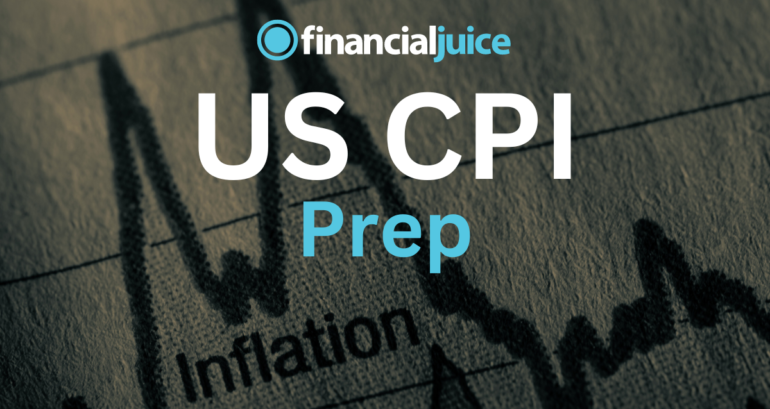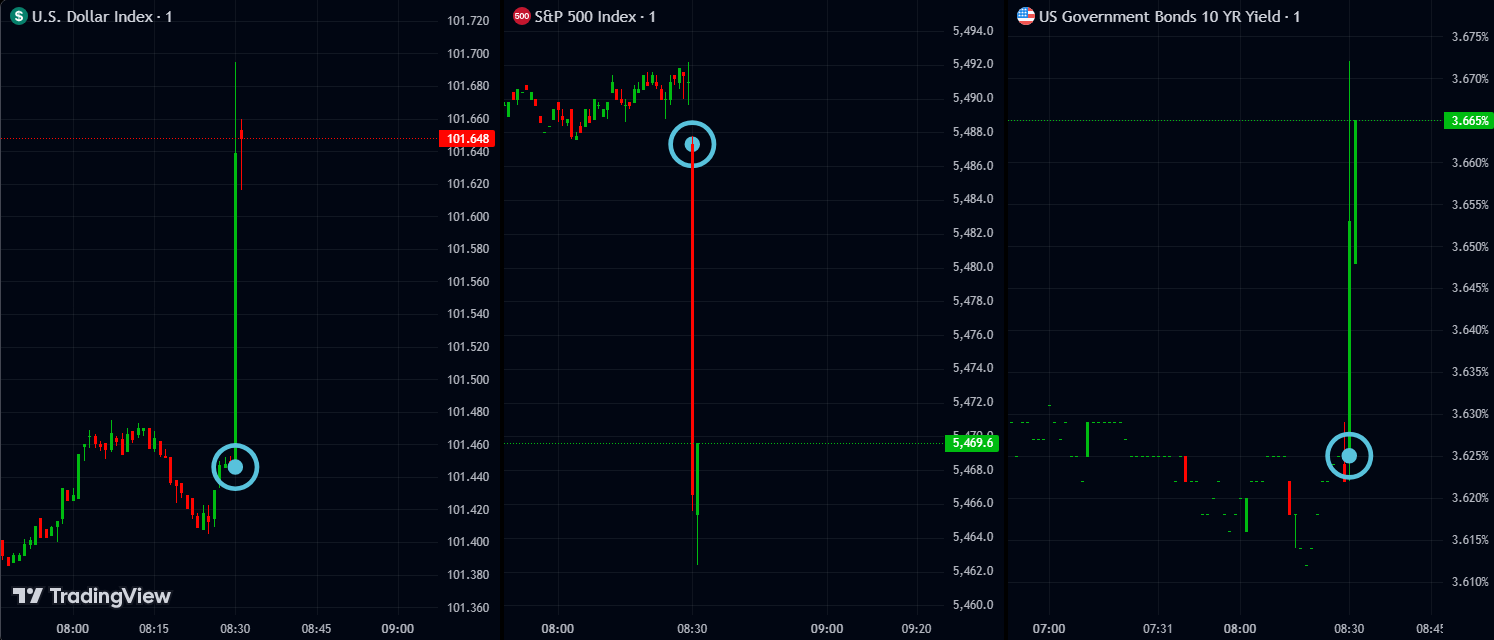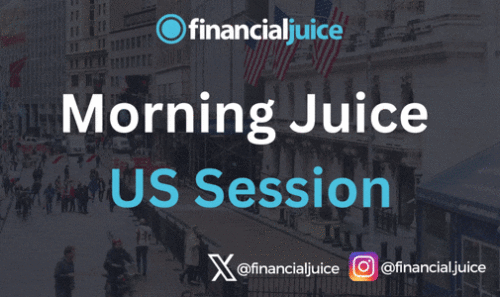
US CPI Prep
On Wednesday the 10th of October, at 08:30 ET, the BLS is set to release the latest US CPI report for the month of September.
Here are some views on what to expect.
Overview
For US CPI YoY, the median forecast is 2.3%, from the prior of 2.5%.
According to a survey of 43 economists, the highest estimate is 2.4%, and the lowest is 2.2%.
For US CPI MoM, the median forecast is 0.1%, from the prior 0.2%.
The highest estimate is 0.2%, the lowest is 0%.
For US Core CPI YoY, the median forecast is 3.2%, unchanged from the prior 3.2%.
The highest estimate is 3.3%, the lowest is 3.1%.
For Core CPI MoM, the median forecast is 0.2, from the prior 0.3%.
The highest estimate is 0.3%, the lowest is 0.1%.
Here are the views from some of the largest investment banks’ forecasters
Wells Fargo
The descent in consumer price inflation has not been particularly smooth. The headline Consumer Price Index (CPI) rose 2.5% year-over-year in August, aided by outright deflation in the goods sector and a general softness in food and energy prices. Yet, firm price pressures in the services sector are keeping a floor under the monthly inflation rate, which in August rose at its fastest pace in four months. Shelter remains the primary culprit behind stubborn services inflation. Despite the marked slowdown in private sector rent measures, shelter inflation accelerated 0.5% over the month of August, the second-highest reading this year. Core CPI picked up in turn, rising at a 0.3% monthly rate (0.28% unrounded).
We maintain the view that shelter inflation should slow more materially in the months ahead. Inflation drivers are poised to swap in September, with a pickup in auto prices primed to lift goods inflation and shelter inflation likely to fall back from the pop in August. All told, we expect core CPI to advance 0.3% in September (0.26% unrounded), which would keep the annual rate unchanged at 3.2%. Lower prices at the pump set the stage for a more substantial downshift in headline CPI, which we estimate rose just 0.1% in September. If realized, the headline inflation rate would ease to 2.3%, equal to the inflation rate immediately before the pandemic in February 2020.
JPMorgan
While inflation continues to cool, in recent months that has been more evident in the core personal consumption expenditure (PCE) deflator than in the core consumer price index (CPI). That dichotomy looks likely to continue again in September, with another relatively solid 0.3% monthly gain for the core CPI (excluding food and energy) that keeps the year-ago core inflation rate at 3.2% — although key sources of strength once again are likely to be categories not pulled into the PCE, such as housing and airfares.
Headline CPI inflation, meanwhile, should expand a soft 0.1% in September, despite more expected firmness in the core measure. Energy prices likely declined 2.2% last month. Although energy prices likely were weak across the board, an expected 4.1% plunge in gasoline prices should have led that measure much lower last month. Currently the downside risk to oil prices from OPEC+ casting aside its production limits appears more consequential than the upside risk from a wider geopolitical conflict in the Middle East. Meanwhile, food price inflation should continue to grow moderately, with a 0.2% rise in September. Overall, the year-ago inflation rate for headline CPI should decelerate to 2.3% in September, its slowest pace since early 2021 as the pandemic-related surge in inflation was just beginning. Such readings, if realized, likely leave the Fed still having greater confidence in the underlying disinflation process, assuming no large adverse shock to supply.
Morgan Stanley
We expect Core CPI prices rose 0.26% in September (0.2%M consensus, 3.2%Y), slightly below the August print. Goods inflation moves into positive territory on used cars, and airfares inflation remains positive. Services inflation decelerates as shelter steps down. We think the upswing in OER last print was in part noise and may reflect a temporary push from seasonal factors, we expect partial correction. Lower gasoline prices bring headline inflation below core again– we expect headline CPI at 0.09%M (headline CPI NSA index: 314.718). Our CPI forecast is consistent with core PCE at 0.19%M vs 0.13%M in August. Used cars carry a lower weight in core PCE and, therefore, their acceleration has a lower impact on PCE inflation relative to CPI. In terms of the PCE components that do not come from CPI, we expect acceleration in health services CPI after two weak months, but softer financial services and airfares.
We see the annualized 3-month pace for core PCE at 1.94% in September (2.06% in August) and the 6-month pace at 2.1% (2.4% in August). Exhibit 2 shows our core PCE forecast at the 1-month, 3-month, and 12-month annualized pace through 2025. We expect the 3-month pace of inflation roughly around target before the November meeting. In this context, we think the Fed will continue to normalize interest rates. A still solid labor market points to two 25bp cuts in November and December this year.
Deutsche Bank
The highlight of the week will be the September US CPI print on Thursday ahead of the next Fed meeting on November 7. Our US economists see MoM growth slowing, with the headline gauge coming in at +0.05% vs +0.2% in August and the core at +0.24% (0.3%). On Friday, there will also be the PPI print and our economists expect +0.2% MoM growth, the same as in August. An update on consumer sentiment will come that day as well with the preliminary University of Michigan consumer survey for October due (DB forecast 68.1 vs 70.1 in September).
Societe Generale
We anticipate only a 0.1% increase in the September CPI and see potential for an unchanged reading. Gasoline prices decreased significantly but are poised to rise for October. Core readings reflect the underlying trend, and core CPI remains stubborn on rent pressures. It may be just a matter of time for rents to soften, but already it has taken longer than anticipated.
Previous Release
On September 12th at 08:30 ET, the BLS released the US CPI report for the month of August.
US CPI YoY came in as expected at 2.9%.
Core CPI YoY came in as expected at 3.2%.
CPI MoM came in as expected at 0.2%.
Core CPI MoM came in higher than expected at 0.3%, up from the forecast 0.2%.
This resulted in US stocks weakening whereas the Dollar and Treasury Yields rose.






